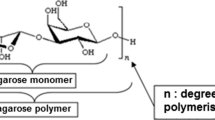Abstract
The gelation of agarose is investigated by rheological methods and electron microscopy, as well as the thickening properties of xanthan. The gelling and thickening agents have been investigated in pure water to compare the results with theoretical models. The gelation of agarose was shown to follow two steps upon cooling, which could be addressed to the formation of helices and their aggregation. In addition to the rheology, transmission electron micrographs of freeze-dried samples have been taken to underline the date by corresponding structures at different stages of the gelling process. The xanthan molecules, which have been approximated by rigid highly charged rodlike molecules, undergo a jamming transition at a critical concentration. This concentration shows a strong dependence on the length of the molecules, which supports the high thickening effect of xanthan. When both, agarose and xanthan are mixed, the gel structure becomes very different. The gelling process is now determined by one step only. It is proposed that the jamming xanthan molecules prevent the formation of the aggregates of the agarose gel. The gels themselves appear then less elastic, and should yield a better mouth feeling.















Similar content being viewed by others
References
E.R. Morris, Functional Interactions. In Gelling Biopolymer Mixtures In “Modern Biopolymer Science”, ed. by Kasapis et al. (Elsevier, 2009), pp. 167–198
G. Phillips, P. Williams (eds.), Handbook of Hydrocolloids, 2nd edn. (Woodhead, Cambridge, 2009)
K.T. Nejenhuis, Thermoreversible networks, viscoelastic properties and structure of gels. Adv Polym Sci (Book series) 129, 194–202 (1997)
M. Rinaudo, Review—Main properties and current applications of some polysaccharides as biomaterials. Polym Int 57, 397–430 (2008)
J.-M. Guenet, C. Rochas, Agarose sols and gels revisited. Macromol Symp 242, 65–70 (2006)
J.-Y. Xiong et al., Topology evolution and gelation mechanism of agarose gel. J Phys Chem B 109, 5638–5643 (2005)
E. Fernández et al., Rheological and thermal properties of agarose aqueous solutions and hydrogels. J Polym Sci, B: Polym Phys 46, 322–328 (2008)
R. Meena et al., Development of a robust hydrogel system based on agar and sodium alginate blend. Polym Int 57, 329–336 (2008)
K.A. Ross et al., The effect of mixing conditions on the material properties of an agar gel-microstructural and macrostrcutural considerations. Food Hydrocolloids 20, 79–87 (2006)
M. Tako, S. Nakamura, Gelation mechanism of agarose. Carbohydr Res 180, 277–284 (1988)
K.-W. Song et al., Rheology of concentrated xanthan gum solutions: steady shear flow behavior. Fiber Polym 7(2), 129–138 (2006)
S.F. Edwards, T.A. Vilgis, The dynamics of the glass transition. Phys Scr T13, 7–16 (1986)
K.C. Labropoulos et al., Dynamic rheology of agar gels: theory and experiments. Part II: gelation behavior of agar sols and fitting of a theoretical rheological model. Carbohydr Polym 50, 407–415 (2002)
E. Pelletier et al., A rheological study of the order-disorder conformational transition of xanthan gum. Biopolymers 59, 339–346 (2001)
J. Fujiwara et al., Structural change of xanthan gum association in aqueous solutions. Thermochim Acta 352–353, 241–246 (2000)
P.G. De Gennes, Scaling principles in polymer physics (Cornell University, Ithaka, 1979)
M. Doi, S.F. Edwards, The theory of polymer dynamics (Oxford University Press, Oxford, 1986)
Z.H. Mohammed et al., Kinetic and equilibrium processes in the formation and melting of Agarose gels. Carbohydr Polym 36, 15–26 (1998)
J.-L. Barrat, J.-F. Joanny, Theory of polyelectrolyte solutions. Adv Chem Phys 94, 1 (1996)
B. Miao, T.A. Vilgis, Conformation dependend condensation of counterions in stiff and flexible polyelectrolytes. (2011) (in press)
T.A. Vilgis, R. Borsali, Mean - feild - theory of concentrated polymer solutions: statics and dynamics. Phys Rev A 43, 6857–6874 (1991)
S.M. Fiszman, L. Durán, Effects of fruit pulp and sucrose on the compression response of different polysaccharides gel systems. Carbohydr Polym 17, 11–17 (1992)
Acknowledgement
The authors thank Sania Maurer, Ann Junghans, Birgitta Schiedt, Gustav Waschatko, Bing Miao and Harald Pleiner for helpful discussions and valuable remarks on earlier versions of the manuscript.
Author information
Authors and Affiliations
Corresponding author
Rights and permissions
About this article
Cite this article
Nordqvist, D., Vilgis, T.A. Rheological Study of the Gelation Process of Agarose-Based Solutions. Food Biophysics 6, 450–460 (2011). https://doi.org/10.1007/s11483-011-9225-0
Received:
Accepted:
Published:
Issue Date:
DOI: https://doi.org/10.1007/s11483-011-9225-0




